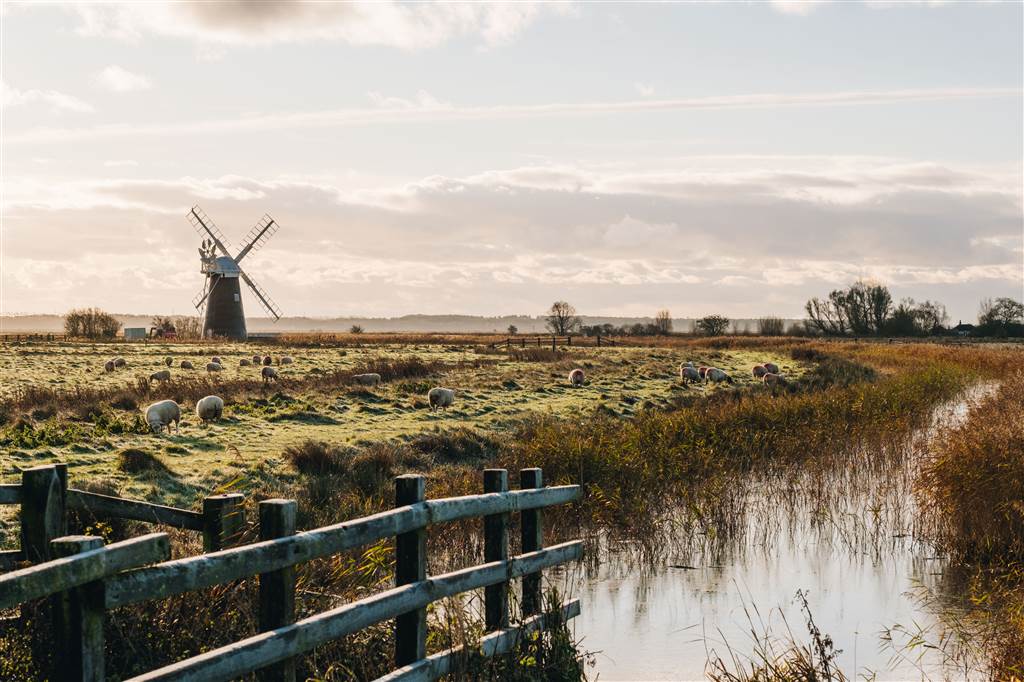

“Where can I see a windmill?” is one of the popular questions for staff at our information centres. But do many of the enquirers realise that most of the mills in the Broads are drainage windmills, not mills for grinding corn?
Today there are still 63 drainage mills of all kinds left in the Broads, a reminder of the endeavour to drain the marshes over the last 400 years. However, the majority of the mills were built from the early 1800s to the early 1900s, to drain the marshes dry enough for keeping cattle and growing crops.
The Water, Mills & Marshes programme, which concluded recently and was led by the Broads Authority and funded by the National Lottery Heritage Fund, included a major project to restore four of the drainage mills in the Halvergate Marshes area and one other, further up the River Yare. These were Mutton’s Mill and High’s Mill, both near Halvergate; Six Mile House Mill, across the River Bure from Runham; North Mill, near Reedham; and Strumpshaw Steam Engine Pump House (a rare steam-powered mill) on the RSPB reserve at Strumpshaw Fen. The work was carried out involving students from City College Norwich, providing training in heritage building and carpentry techniques to help encourage a future workforce to care for historic buildings. The project has received several awards, the latest was in autumn 2023, when the Broads Authority won the prestigious Norwich and Norfolk Design and Craftsmanship Award in the conservation category for the work at Mutton’s Mill. We were also overall winner for sustainability. The awards are made by the Norfolk branch of the Royal Institute of British Architects, the Norwich Society and Norwich University of the Arts.

By their nature mills aren’t always easy to visit, they are often in remote locations and can involve a lot of steps to climb if they include inside access. Of the recently restored Halvergate Marshes mills, Mutton’s (about 1.5 miles from Halvergate) is one of the easiest to visit (external viewing only). You can also follow the Halvergate Mills Trail, starting from Stones Road at Halvergate, or Berney Arms Station. It’s a beautiful circular walk, but at about eight miles over rough ground, it takes about four hours, so it’s not for everyone. On the trail you can also see English Heritage’s Berney Arms Mill, one of the tallest in the country, which is awaiting further restoration. This video will tell you about the restoration of Mutton’s Mill.
Another Water, Mills & Marshes project, WISEArchive’s Life and Work on the Broads 1920-2020, will help you find out more about what it was like to work the mills.
At the other end of the accessibility scale, the restored Horsey Windpump is easily reached by road or water and is fully accessible to view externally, plus the ground floor is accessible to wheelchair users. Restored Thurne Mill is a short walk (about 100m) along Thurne Dyke and is also a great location to experience the dark skies of the Broads for a bit of stargazing. If you visit How Hill you can see the mills there and the restored Stubb Mill is on the Norfolk Wildlife Trust’s nature reserve at Hickling.
You can see Herringfleet Mill from the Herringfleet 24-hour moorings, or by walking from Herringfleet Hills or Somerleyton (about a mile). Saint Olave’s Mill is not far away and is one of many cared for by the Norfolk Windmills Trust. You can walk to it downstream from St Olave’s Bridge near the Bell Inn (about a mile). The trust’s other mills include Stracey Arms (on the River Bure and the A47, about 2.5 miles from Acle) and a whole group of mill buildings (including North Mill and Polkey’s Mill), which you can walk to on the Wherryman’s Way from Reedham (about 2 miles). Another of the trust’s mills is fully restored Hardley Mill, open to visitors arriving by water or on foot from Hardley Staithe (about a mile). “If the sails are turning – we are open,” they say. Another video will tell you all about the mill and explain how drainage mills actually worked…
You can even stay in a Broads mill if you wish, in corn mills at Sutton and How Hill, or in a drainage mill at Stalham.
Last but not least, there’s National Mills Weekend, 11-12 May 2024. Happy visiting!